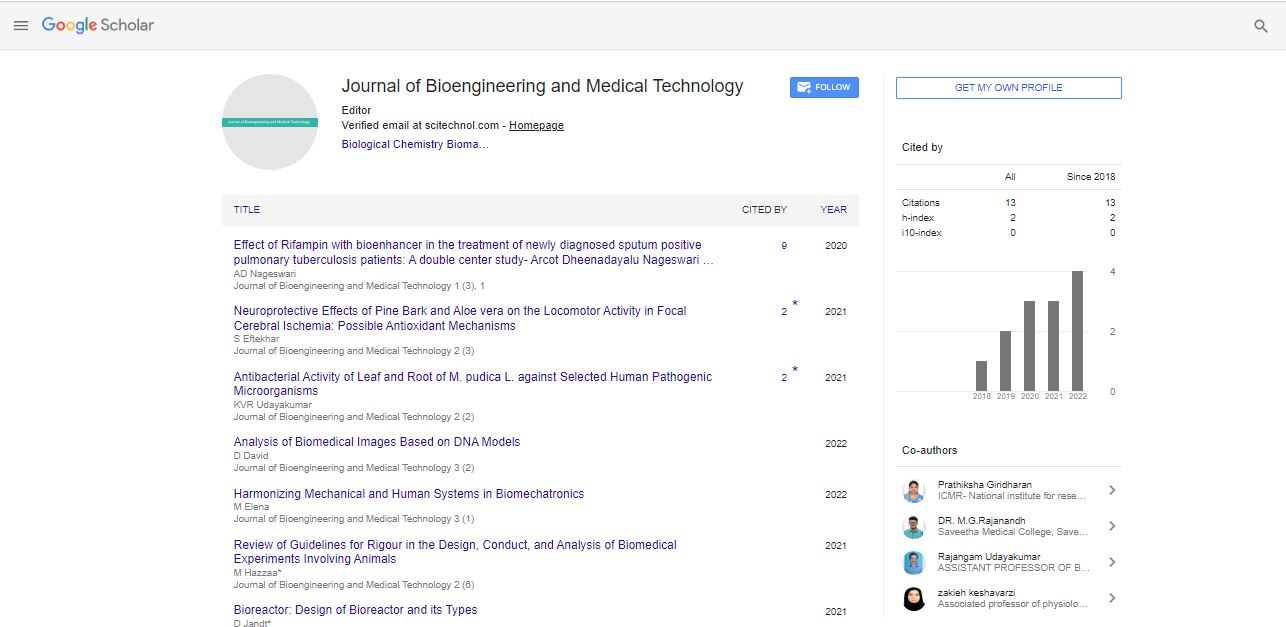Commentary, J Bioeng Med Technol Vol: 4 Issue: 1
Pushing the Limits of Nanoscale Engineering: New Horizons and Frontiers
Endalkachew S*
Department of Medicine, Royal Brisbane Hospital, Queensland, Australia
*Corresponding Author: Endalkachew S
Department of Medicine, Royal
Brisbane Hospital, Queensland, Australia
E-mail: endalkachew5@gmail.com
Received date: 22 February, 2023, Manuscript No. JBMT-23-96043;
Editor assigned date: 27 February, 2023, Pre QC No. JBMT-23-96043(PQ);
Reviewed date: 14 March, 2023, QC No. JBMT-23-96043;
Revised date: 21 March, 2023, Manuscript No: JBMT-23-96043(R);
Published date: 28 March, 2023, DOI: 10.35248/jbmt.1000069
Citation: Endalkachew S (2023) Pushing the Limits of Nanoscale Engineering: New Horizons and Frontiers. J Bioeng Med Technol 4:1.
Description
Nano scale engineering has become a fundamental aspect of many fields such as electronics, materials science, and biomedicine. The ability to manipulate matter at the atomic and molecular level has led to numerous advancements in science and technology. Researchers are continuously pushing the limits of Nano scale engineering to explore new horizons and frontiers. In this essay, we will discuss some of the recent developments in Nano scale engineering and how they are pushing the boundaries of what is possible. One of the most exciting areas of nanoscale engineering is in the field of electronics. The demand for faster and more efficient computing has led researchers to develop nanoscale electronic devices. One example is the use of carbon nanotubes in transistors. Carbon nanotubes are tiny tubes made up of carbon atoms that are just a few nanometers in diameter. They have unique electrical and mechanical properties that make them ideal for use in transistors. These tiny devices have the potential to revolutionize electronics by making them faster, smaller, and more energy-efficient. Another area where nanoscale engineering is making strides is in the field of materials science. Scientists are now able to engineer materials with unprecedented precision at the nanoscale level. For example, researchers have developed a new type of superstrong material by using carbon nanotubes and graphene. This material is incredibly lightweight but has a tensile strength that is 10 times stronger than steel. It has the potential to be used in a wide range of applications, from aerospace to sports equipment.
In biomedicine, nanoscale engineering is being used to develop new diagnostic tools and therapies. Nanoparticles are being used as drug delivery vehicles, allowing for targeted drug delivery to specific cells in the body. These nanoparticles can be designed to release drugs in response to specific signals, such as changes in pH or temperature. This allows for more efficient and targeted drug delivery, reducing side effects and improving treatment outcomes. Nanoscale engineering is also being used to develop new imaging techniques for medical diagnostics. For example, researchers have developed a new type of nanoscale MRI contrast agent that can target specific cancer cells. This allows for earlier and more accurate detection of cancer, leading to better treatment outcomes.
In addition to these areas, nanoscale engineering is also being used to develop new energy technologies. For example, researchers are developing new materials for use in solar cells that are more efficient at converting sunlight into electricity. These materials are being engineered at the nanoscale level to optimize their properties and improve their performance. Despite the much advancement in nanoscale engineering, there are still many challenges that need to be addressed. One of the biggest challenges is the issue of scalability. While it is possible to manipulate matter at the atomic and molecular level, scaling up these techniques to produce usable products on a large scale is difficult. This is a significant hurdle that needs to be overcome for many applications of nanoscale engineering. Another challenge is the issue of safety. As the use of nanoscale materials becomes more widespread, it is important to understand the potential health and environmental risks associated with their use. Research in this area is ongoing, and it is essential that safety concerns are addressed before these materials become more widely used.
In conclusion, nanoscale engineering is an exciting field that is pushing the limits of what is possible in science and technology. Researchers are continuously developing new techniques for manipulating matter at the atomic and molecular level, opening up new horizons and frontiers in electronics, materials science, biomedicine, and energy. While there are still challenges to be addressed, the potential benefits of nanoscale engineering are enormous, and it is likely that this field will continue to be an area of intense research and innovation in the coming years.
 Spanish
Spanish  Chinese
Chinese  Russian
Russian  German
German  French
French  Japanese
Japanese  Portuguese
Portuguese  Hindi
Hindi 
